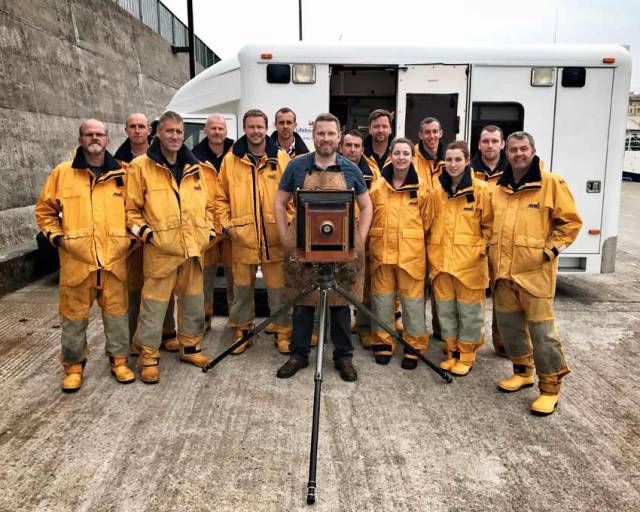#RNLI - More than two years ago, Jack Lowe began an ambitious project to photograph every RNLI station with a Victorian-era camera.
Now, having already photographed 88 of the 238 lifeboat stations in these islands, Jack Lowe has finally arrived in Ireland.
Lowe, a photographer from Newcastle upon Tyne, is travelling around the UK and Ireland in a converted ambulance photographing RNLI lifeboat volunteers through a Victorian process that captures the stunning images on glass in whats one of the largest project’s of its kind ever undertaken.
Taking the Lifeboat Station Project to Ireland, the first RNLI volunteer crews he will visit include Dunmore East, Tramore and Helvick Head in Co Waterford; and Youghal, Ballycotton, Crosshaven, Kinsale, Courtmacsherry, Baltimore and Castletownbere in Co Cork; finishing up at Valentia in Co Kerry to mark his 99th lifeboat station.
“Believe it or not, this is the first time I’ve ever visited Ireland,” said Lowe. “I can’t wait to see the stunning coastline and meet the Irish lifeboat crews I’ve heard so much about.
“I am excited to see the results of this mission sitting alongside the glass plates I’ve been making in the UK. I’d been told there's a welcome like no other from the Irish and I’m already experiencing it after just two days.”
Completing the entire project is likely to take five years in total, and is set to be the first complete photographic record of every single lifeboat station on the RNLI network. Lowe expects reach the half-way point in 2018.
The photographer, grandson of Dad’s Army actor Arthur Lowe, is also an avid RNLI supporter. “My early childhood was spent on a Victorian schooner in Ramsgate harbour and on the Thames,” he recalls. “My dad is an experienced seafarer and introduced me to the wonders of lifeboats — these incredible, powerful pieces of kit designed for heroic, lifesaving missions on stormy seas.
“From an early age, I loved photography and lifeboats. Now I’m following my heart and uniting the two passions. I’m using a photographic technique developed in the 1850s, around the time that the RNLI was incorporated under Royal Charter. The photographs are made directly onto glass plates known as ‘ambrotypes’.”
When Lowe visits a lifeboat station, he makes the portraits using a camera made in 1905, and then develops the images in the mobile darkroom within his decommissioned NHS, named ‘Neena’, which he purchased on eBay.
The volunteer lifeboat crew members are able to step into the ambulance and watch as their portraits appear on the glass plates — an experience Lowe says they find fascinating, and sometimes very moving.
Lowe began drawing up plans for the project over two years before it began. He says he has always had an interest in the history of photography.
“The word photography means drawing with light and that is how I think about it still. I adore photography in this very raw, basic form — light falling on chemicals. It really is magical – the final image is always a surprise, even to me.”
He adds: “There’s a small global community of people interested in using these old techniques. Everyone works in their own way – and you’re always learning as you go along. The chemicals are the original formulae from the 1800s.
“It took me a long time to figure out the logistics of transporting and storing glass plates. I have a box made for each station that holds ten sheets of 12x10 inch glass. Then when I get them back to Newcastle I scan them, varnish them and then place them into storage.”
Follow Jack Lowe’s RNLI photographic mission on Instagram, Facebook, Twitter or on the Lifeboat Station Project’s dedicated site.
































































